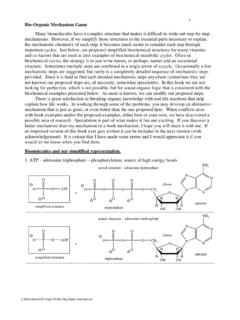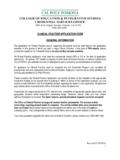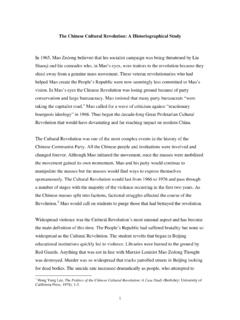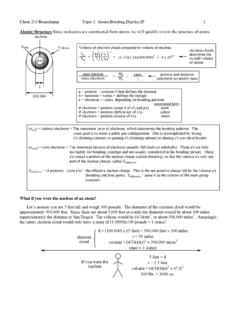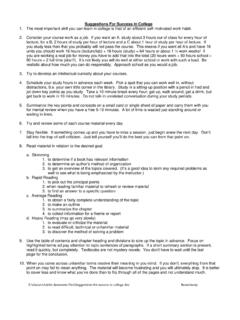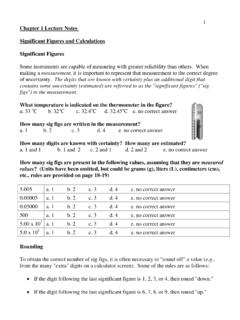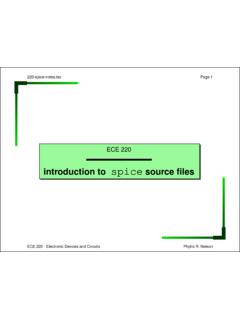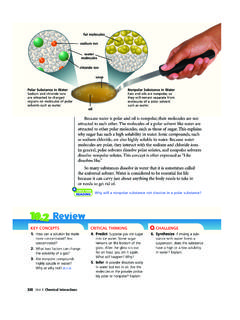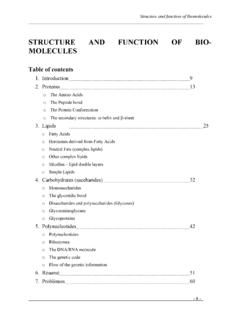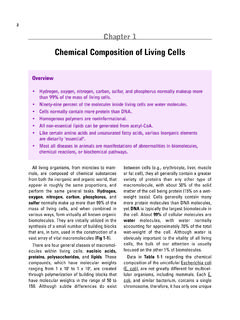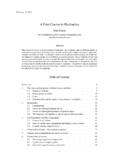Transcription of 1 Lecture 2 Simple Molecular Orbitals - Sigma and …
1 1 Lecture 2 Simple Molecular Orbitals - Sigma and Pi Bonds in molecules bond order = (number of bonding electrons) - (numberof antibonding e lectrons) 2= amount of bonding 1sahydrogen molecule = H2 LUMOHOMO = 1sa + 1sb = bonding MO =potential energy higher,less stable lower,more stableLUMO = lowest unoccupied Molecular orbitalHOMO = highest occupied Molecular orbitalSimilar phase of electron density (no node) adds together of isolated atomsbond order (H2 molecule) =(2) - (0) 2= 1 bond1sbHHHHHH = 1sa - 1sb = antibonding MO =LCAO = linear combination of atomic orbitalsnode = zero electron density because of opposite phases E = bond energyThere is a big energy advantage for a hydrogen molecule over two hydrogen atoms.
2 Sigma ( ) bonding Molecular orbital - Shared electron density is directly between the bonding atoms, along the bonding axis. A Sigma bonds is always the first bond formed between two atoms. Sigma star ( *) antibonding Molecular orbital Normally this orbital is empty, but if it should be occupied, the wave nature of electron density (when present) is out of phase (destructive interference) and canceling in nature. There is a node between the bonding atoms (zero electron density). Problem 1 What would the MO pictures of He2, H2+, H2- and He2+ look like? Would you expect that these species could exist? What would be their bond orders? node = zero electron density because of opposite phases2pa bondLUMOHOMO = 2pa + 2pb = bonding MO =potential energy higher,less stable lower,more stableLUMO = lowest unoccupied Molecular orbitalHOMO = highest occupied Molecular orbitalSimilar phase of electron density (no node) adds together of isolated p orbitalsbond order of a pi bond =(2) - (0) 2= 1 bond2pb = 2pa - 2pb = antibonding MO =LCAO = linear combination of atomic Orbitals E = bond energyThere is a big energy advantage for a pi bond over two isolated p is above and below the bond axis, not directly between the bonded atoms.
3 2 Lecture 2 Pi bond ( ): bonding Molecular orbital The bonding electron density lies above and below, or in front and in back of the bonding axis, with no electron directly on the bonding axis, since 2p Orbitals do not have any electron density at the nucleus. These are always second or third bonds overlapping a Sigma bond formed first. The HOMO of a pi system is especially important. Pi star ( *): antibonding Molecular orbital Normally this orbital is empty, but if it should be occupied, the wave nature of electron density is out of phase (destructive interference) and canceling in nature. This produces repulsion between the two interacting atoms, when electrons are present. Atoms gain a lot by forming Molecular Orbitals . They have more stable arrangement for their electrons and the new bonds help them attain the nearest Noble gas configuration.
4 The Hybridization Model for Atoms in molecules The following molecules provide examples of all three basic shapes found in organic chemistry. CHHHCHHHCHCHCbCaHHCa ethanetetrahedral carbon atomsHCH bond angles 109o HCC bond angles 109o ethenetrigonal planar carbon atomsHCH bond angles 120o (116o)CCH bond angles 120o (122o) ethynelinear carbon atomsHCC bond angles = 180o allenetrigonal planar carbon atomsat the ends and a linear carbon atom in the middleHCaH bond angles 120o HCaCb bond angles 120oCaCbCa bond angles = 180oCCHHHHHH To understand these shapes we need to understand hybridization or atomic Orbitals . In organic chemistry our orbital mixtures will be Simple combinations of the valence electrons in the 2s and 2p Orbitals on a single carbon atom.
5 Though not exactly applicable in the same way for nitrogen, oxygen and the halogens, this model will work fine for our purposes in beginning organic chemistry. We will mix these Orbitals three ways to generate the three common shapes of organic chemistry: linear (2s+2p), trigonal planar (2s+2p+2p) and tetrahedral (2s+2p+2p+2p). 1. sp hybridization carbon and other atoms of organic chemistry 2p's2s isolated carbon atom (not typicalin our world)promote a 2s electron to a 2p orbitalmix (2s and 2p), two ways (2s + 2p) and (2s - 2p) to create two sp hybrid orbitals2p's2s2pspsp arrangement for carbon atom bonded to other atoms,two p Orbitals remain to become part of pi bonds2pspOverall, this would be a favorable = promotion energy 100 kcal/molegain = electron/electron repulsion in s ortibal is removed 20-40 kcal/molegain = two additional bonds are possible 150-200 kcal/molegain = more directional Orbitals form, that have better overlap of electron density between the bonding atoms, thus forming stronger bondspotential energy higher,less stable lower,more stable 3 Lecture 2 CC CCHC CHCH CHCC CC CCCCtop and bottomfront and backEthyne has five total bonds.
6 Three Sigma bonds and two pi + 2pspa2s2p (reverses phase)2s - 2pspbaddsubtractThe nucleus of the carbon atom is nucleus of the carbon atom is here. superimposeorbitals (2s + 2p) superimposeorbitals (2s - 2p)CCspaspbThis represents the spb hybrid orbital. The small, opposite phase lobe on the backside has been left off to simplify the represents the spa hybrid orbital. The small, opposite phase lobe on the backside has been left off to simplify the isolated sp hybridized carbon atom for viewing. A bonded carbon atom would need orbital overlapfor each orbital present, spa, spb, 2pz and remain two 2p Orbitals which are perpendicular to the two sp hybrid Orbitals and to each other. Each 2p orbital extends along its entire axis with opposite phase in each has one electron available for each orbital to share with bonding hybridized carboncarbon atom shape = linearbond angles about sp carbon = 180onumber of Sigma bonds = 2number of pi bonds = 2 These terms all go together.
7 For neutral sp carbon, knowing any one of them, implies all of the Complete Picture of an sp Hybridized Carbon Atomsp HybridizationIndividual bonds in a molecule of ethyne (..its common name is acetylene)The complete picture of two sp carbon atoms bonded in a molecule of ethyne. 4 Lecture 2 We rarely draw our 3D structures like this, preferring simpler ways of representing the details. H2 CCH3D ethyne drawn with p Orbitals as lobes (p Orbitals with phase shown in the left structure and without phase in the right ways of drawing 3D structures that are simpler than the above drawing at showing the 3D ethyne drawn with p Orbitals as lines and pi electrons explicitly drawn in, in a manner similar to showing lone pair electrons. In this book I will usually draw pi bonds this way in 3D structures.)
8 P orbital lobes are in the plane of the orbital lobe is in back of the orbital lobe is in front of the paper. CHCHEach line represents a bond. While the three Simple lines of the triple bond appear equivalent, we know that the first bond formed is a Sigma bond of overlapping sp hybrid Orbitals . The second and third bonds are overlapping 2p Orbitals , above and below and in front and in back. Since the C-H bonds are single bonds, we know that they are Sigma bonds too, using hybrid Orbitals . This is how you will determine the hybridization of any atom in a structure. Knowing how many pi bonds are present will tell you how many 2p Orbitals are being used in those pi bonds. The remaining s and 2p Orbitals must be mixed together in hybrid Orbitals (in this example, only an s and a 2p remain to form two sp hybrid Orbitals ).
9 HCCHThe connections of the atoms are implied by the linear way the formula is drawn. You have to fill in the details about the number of bonds and where they are from your understanding of each atom's bonding patterns. A C-H bond can only be a single bond so there must be three bonds between the carbon atoms to total carbon's normal number of four bonds. This means, of course, that the second and third bonds are pi bonds, using 2p Orbitals , leaving an s and p Orbitals to mix, forming two sp hybrid bond line formula only shows lines connecting the carbon atoms and leaves off the hydrogen atoms. Every end of a line is a carbon (two in this drawing) and every bend in a line is a carbon (none in this drawing). You have to figure out how many hydrogen atoms are present by substracting the number of lines shown (bonds to non-hydrogen atoms) from four, the total number of bonds of a neutral carbon (4 - 3 = 1H in this drawing).
10 The shape of the carbon atoms must be linear, because we know the hybridization is of the details in this group go together. If you have any one of them, you should be able to fill in the remaining is the ultimate in condensing a structure. Merely writing the atoms that are present and how many of them there are provides no details about the connectivity of the atoms. It only works for extremely Simple molecules that have only one way that they can be drawn. Ethyne is an example of such molecule. Other formulas may have several, hundreds, thousands, millions, or more ways for drawing structures. Formulas written in this manner are usually not very atom shape = linear hybridization = spbond angles about sp carbon = 180onumber of Sigma bonds = 2number of pi bonds = 2 5 Lecture 2 2. sp2 hybridization 2p's2s isolated carbon atom (not typicalin our world)promote a 2s electron to a 2p orbitalmix (2s and two 2p's)
